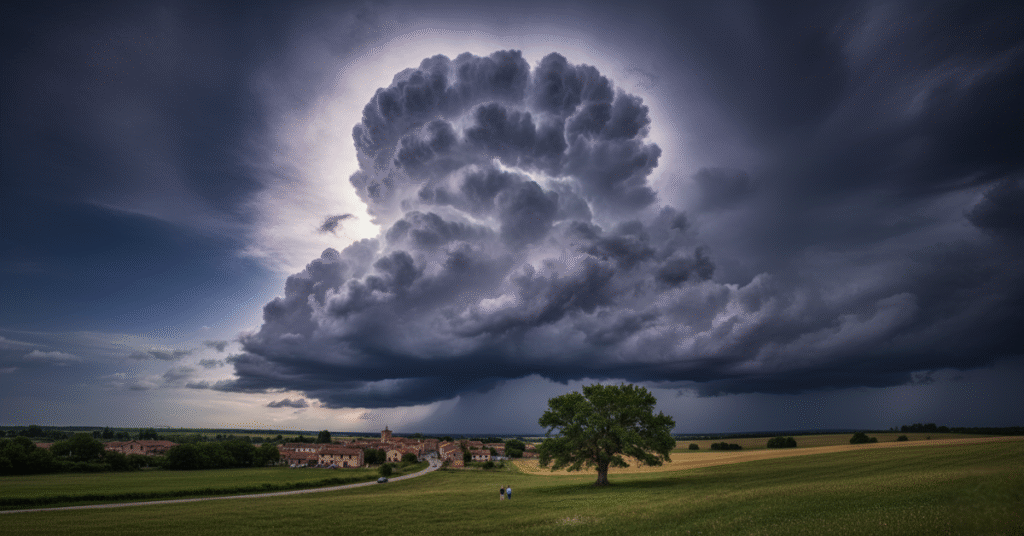How much does a cloud weigh? It is a question that completely blew my mind when I first learned the incredible truth: A single, average-sized cloud can weigh over a million tonnes. When I look up at the sky and see those fluffy, white shapes drifting so effortlessly, they look like giant puffs of cotton candy. It’s a peaceful sight, and for years, I never questioned it.
Yes, you read that right. One million tonnes. That’s roughly the weight of 100 fully-loaded double-decker buses, or a dozen massive blue whales!
When I first learned this, I was genuinely confused. As someone who writes facts for a living at FACTOVATE, I immediately had to know how this was possible, and more importantly, how on earth does something so heavy stay up in the air? Let me take you through the incredible science behind this astonishing phenomenon.
The Math Behind the Mass: Calculating Cloud Weight
The idea that a cloud weighs a million tonnes isn’t a guess; it’s based on simple physics and mathematics. Scientists usually look at a specific type of cloud called a cumulus cloud—those classic, puffy ones you see on sunny days.
To figure out how much does a cloud weigh, we need two key measurements:
- The Volume of the Cloud: An average cumulus cloud is huge, often covering an area of about one cubic kilometer ( km$^3$). That’s cubic meters.
- The Density of the Water: Scientists have measured the density of the tiny water droplets and ice crystals inside the cloud. This density is surprisingly low, averaging about grams of water per cubic meter of cloud ( g/m$^3$).
Now, we simply multiply the volume by the density:
Since there are one million grams in a tonne, this calculation tells us that an average cumulus cloud weighs about tonnes.
Wait, what about the million tonnes? The “million tonnes” figure is often used when discussing larger, storm-producing clouds, like the towering Cumulonimbus clouds. These giants are several kilometers wide and tall, easily holding enough water to push their total weight well over the million-tonne mark. So, while tonnes is closer to the average fluffy cloud, the fact that a million tonnes is possible is what makes this so astonishing!
The Floating Mystery: Why Clouds Don’t Crash Down

This is the question that kept me up when I first researched how much does a cloud weigh. If a cloud contains tonnes of water, why doesn’t it simply fall out of the sky and flatten everything below it? The secret is in two main factors: Size and Spacing.
1. The Tiny Size of Droplets: The water inside a cloud isn’t one giant mass; it’s made up of billions upon billions of extremely tiny water droplets or ice crystals. These droplets are so small (less than a hundredth of a millimeter wide) that they are practically invisible to the naked eye.
2. Air Resistance and Updrafts: Because these droplets are so tiny, air resistance (the push of the air upwards) is far greater than the pull of gravity downwards. It’s similar to how a feather falls much slower than a rock. In fact, these droplets are constantly supported by updrafts—warm currents of air that rise from the Earth’s surface. These powerful updrafts keep the lightweight droplets suspended indefinitely.
A cloud is essentially a vast amount of heavy water spread very thinly over an extremely large area. It’s not a solid mass that falls, but a collection of billions of minuscule particles constantly fighting gravity and winning, thanks to air resistance and rising air.
The Big Difference: Rain vs. Floating Water
A cloud only falls when those tiny droplets become too heavy for the air to support. This happens through a process called coalescence, where the droplets bump into each other, stick together, and grow larger. Once a droplet reaches about millimeters in diameter, it becomes heavy enough to overcome the updrafts and air resistance, and that’s when it begins its journey to the ground as rain.
The next time you look up and ask yourself how much does a cloud weigh, remember the incredible balance of physics: a million tonnes of water, held up by nothing but warm air, tiny size, and the power of resistance. It’s one of nature’s most magnificent—and heavy—illusions!






